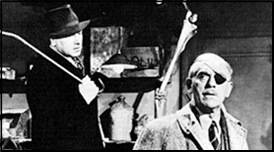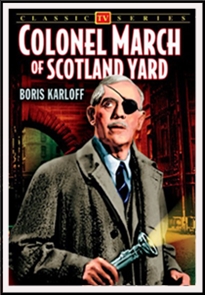Wed 13 Jan 2021
A Locked Room Mystery Movie Review by David Friend: COLONEL MARCH INVESTIGATES (1953).
Posted by Steve under Mystery movies , Reviews , TV mysteries[6] Comments
COLONEL MARCH INVESTIGATES. Criterion Films, UK, 1953. Starring Boris Karloff as Colonel March. Screenplay by Leo Davis, based on three stories written by John Dickson Carr. Director: Cyril Enfield.
The master of the locked room mystery was, inarguably, John Dickson Carr, one of the most popular crime writers of the Golden Age. His masterpiece, The Hollow Man (1935), retains an almost legendary status among crime fiction fans, but he is now sadly forgotten by the wider public. The books have long been out of print in the UK, and I’m always hoping that some publisher will bring them back.

Perhaps they are so obscure because Carr’s most famous sleuths, Dr Gideon Fell and Sir Henry Merrivale, never made it to the screen. One of his lesser characters managed it, however, in the early 1950s, with the television series Colonel March of Scotland Yard.
Carr had used the character only in his 1940 short story collection The Department of Queer Complaints, in which there is a subdivision of Scotland Yard that specialises in crimes of a curious or apparently impossible nature. The series was financed by the Americans and starred international film star Boris Karloff – famous for playing the Chinese-American detective Mr Wong and, of course, even more so, Frankenstein’s Monster.
At this point in his long career, Karloff was a frequent guest on American radio series and even had his own show for children in which he read stories and told riddles. In 1952, he returned to England and made three episodes for ITV which acted as pilots for a longer series. Eventually, twenty six were produced, all of which were a brisk 25 minutes long.
The first three made were stitched together for release to cinemas in 1953. This was not uncommon for a TV show at the time and the practice would continue into the next decade, particularly with The Saint.
Colonel March Investigates is a taut 70 minute anthology of three slight, though entertaining, mysteries with the twinkly-eyed Karloff. He gives the character an eye-patch, which he didn’t have in the stories, but it adds something to the character, as we can imagine he may have lost it in the First World War. This, perhaps, is someone who has witnessed untold horrors and has come to terms with the world by engaging with its more whimsical wonders.

Unsurprisingly, there is a framing device which helps tie the three tales together, in which March stands in his office and inspects a cupboard stocked with souvenirs of his cases before leading the audience into the corresponding story.
The first of these, aired as “Hot Money,” revolves around a bank robbery in which a clerk is incriminated. He follows the criminal to an office, where the money is seemingly stored. However, when the place is searched, the money has apparently disappeared. Despite the clerk being framed in the silliest of ways, the resolution is pretty decent, but nothing too special. Joan Sims appears here in an early role, and March reveals a John Steed-like umbrella sword!
The second story was aired as “Death in the Dressing Room,” which is probably the weakest of the three. Set in a nightclub, it features an exotic dance routine which acts as a clue, while the always reliable Richard Wattis plays the manager. The running time to these is so short that there is virtually no time to set up a number of suspects, so the culprit tends to be the person who has been in it the most.
No matter, as it’s all about how March gets his man, which he does here in a tense confrontation. As usual, March’s sparring partner is the Scottish Inspector Ames (Ewan Roberts), though you wonder why he’s there as March seems to be a famous genius.
The third story, intriguingly titled “The New Invisible Man,” features a peeping tom who has apparently witnessed a pair of animated gloves committing murder, and a scene of a crime with no evidence of a crime. It’s the best one, I think, though there are a couple of problems. We get the opportunity to see the gloves in action ourselves, but it doesn’t look much like the way it’s shown to us in the reveal.
The trick is good, nonetheless, and it certainly had me baffled. The reason behind it all is pretty shaky, however, and involves stolen paintings and, eventually, a kidnapped March. It’s all good fun, though, which is what I’d call the film as a whole. And an interesting peek, as ever, into bygone England. Eight episodes of the series itself are available on DVD. It’s just a pity the complete series isn’t available.
Rating: ***

January 13th, 2021 at 6:29 pm
Karloff has to carry quite a bit of this since there is little time to develop the Carrian plots. But it is Karloff having fun, playful almost, and it is that that allows these to work most of the time.
A bit earlier than this Karloff also got a shot at Sherlock Holmes sort of playing the Holmesian Mr. Mycroft in an adaptation of A TASTE OF HONEY with Robert Flemying as Mr. Sylvester his reluctant Watson.
The entire series is available on a couple of subscription services and worth the time to watch if you love Karloff, Carr, or both.
January 13th, 2021 at 6:55 pm
Yes, you’re right. I missed that. I only knew about the two Alpha Video DVDs of four episodes each. The entire season of 26 episodes is available on Amazon Prime, Roku, Hoopla, and Tubi, and I’ve never heard of the last three.
I’m going to start watching as soon as I can.
January 14th, 2021 at 5:37 am
The adaptation (“Sting of Death”) in which Karloff played Mr. Mycroft was based on “A Taste For Honey”, by Gerald Heard. And Robert Flemyng played Mr. Silchester.
January 14th, 2021 at 11:30 am
Director Cyril Endfield went on to bigger things, and was rather good at them.
January 14th, 2021 at 12:16 pm
Filmography, from 1950 on:
The Underworld Story (1950) – director, writer
The Sound of Fury (1950) – director, writer (incredited)
Tarzan’s Savage Fury (1952) – director
The Limping Man (1953) – director
Impulse (1954) – director, writer
Crashout (1955) – writer (uncredited)
The Master Plan (1955) – director, writer
The Secret (1955) – director, writer
Child in the House (1956) – director, writer
Colonel March of Scotland Yard (1956) – director
Hell Drivers (1957) – director, writer
Curse of the Demon (1957) – writer (uncredited)
Sea Fury (1958) – director, writer
Jet Storm (1959) – director, writer
Mysterious Island (1961) – director
Zulu (1964) – director, writer, producer
Hide and Seek (1964) – director
Sands of the Kalahari (1965) – director, writer, producer
De Sade (1969) – director
Universal Soldier (1971) – director, writer
Zulu Dawn (1979) – writer
January 14th, 2021 at 7:12 pm
Jonathan O
Thanks for the correction on Silchester.
Henry Fitzgerald Heard went by both Gerald and H.F., all the Mycroft books, a series of three, are published as by H. F., at least in the States.